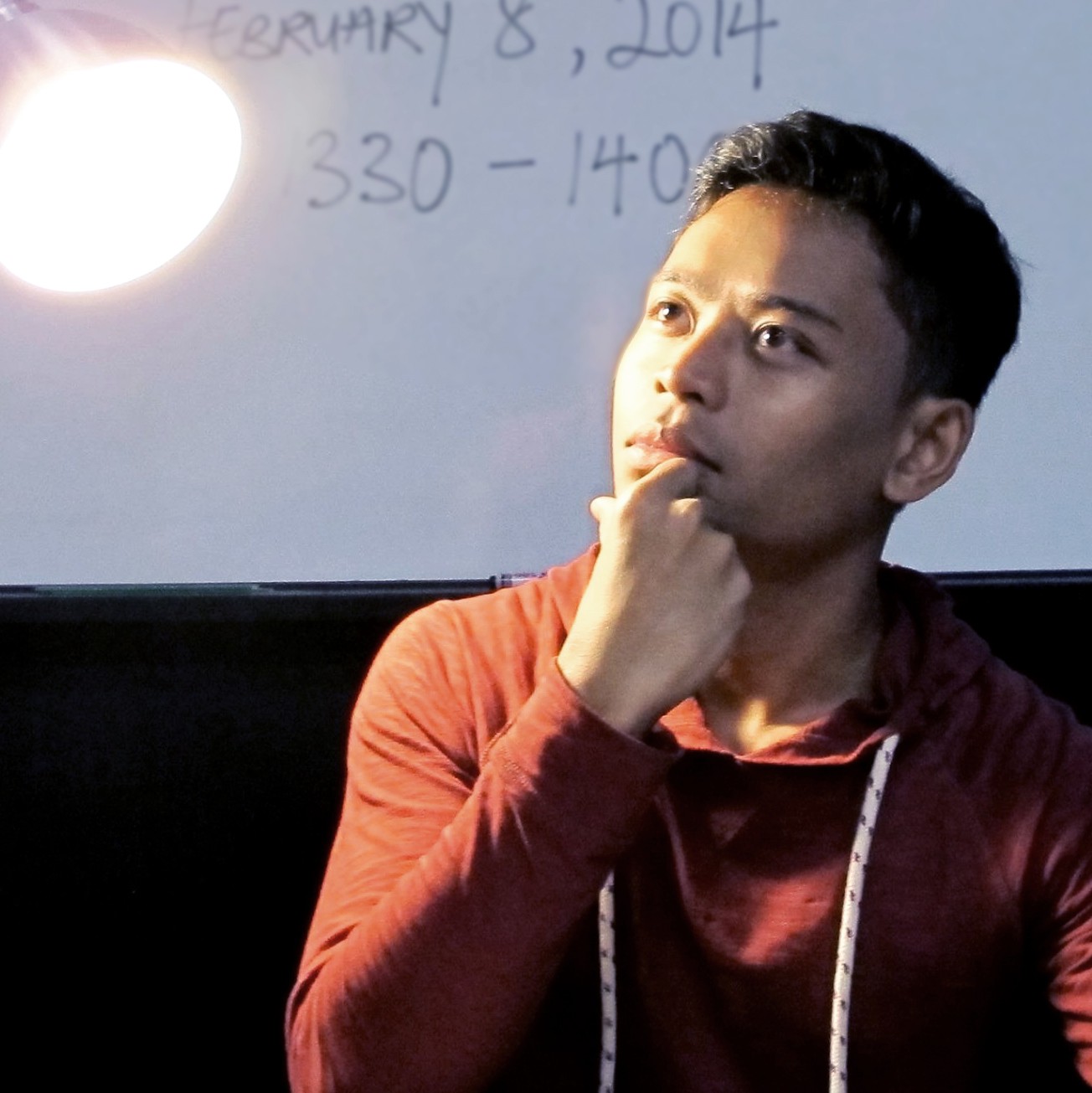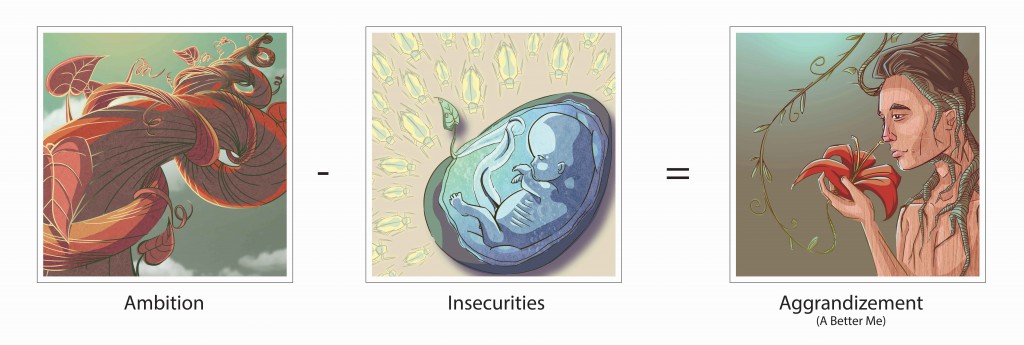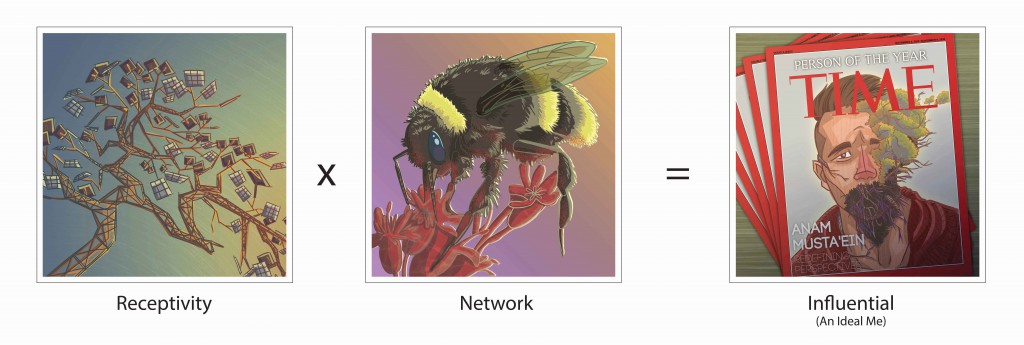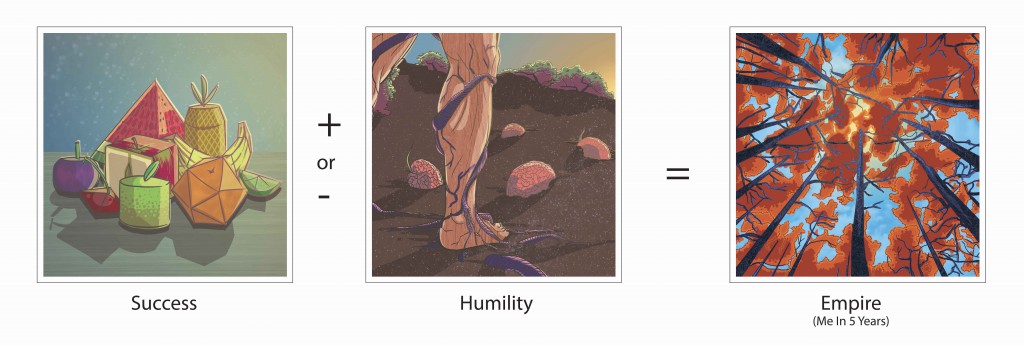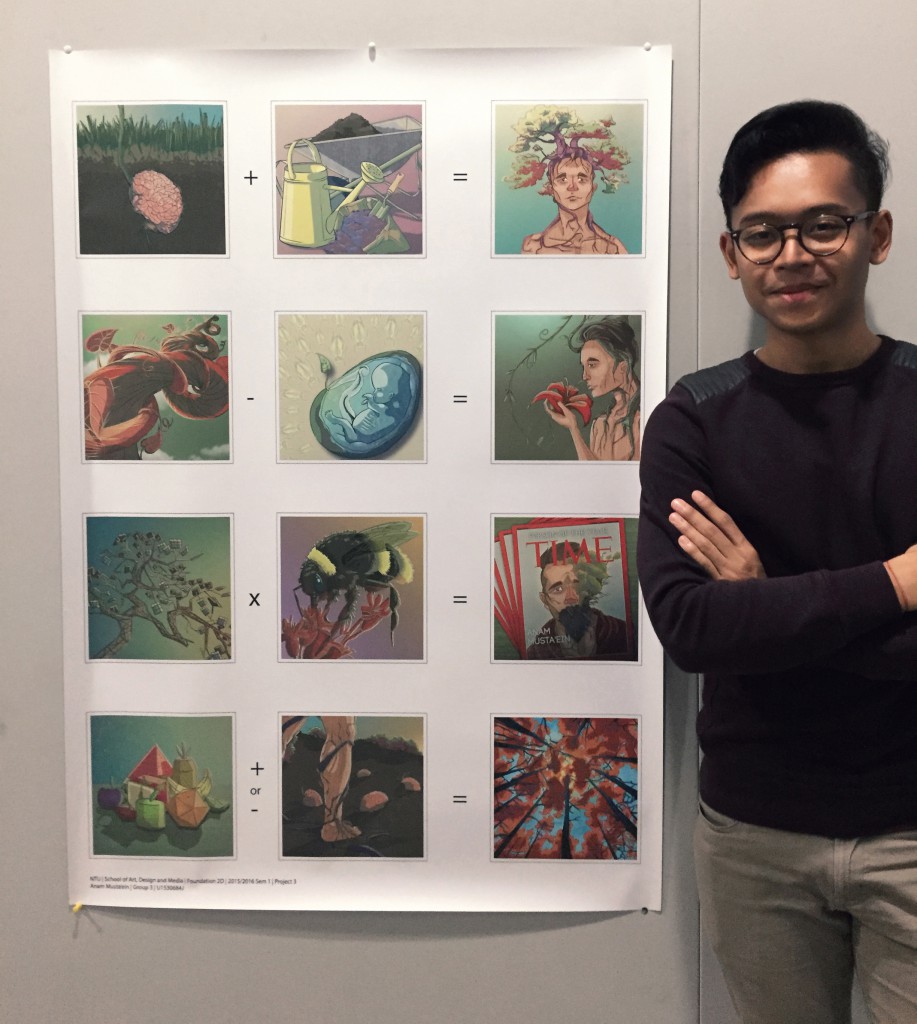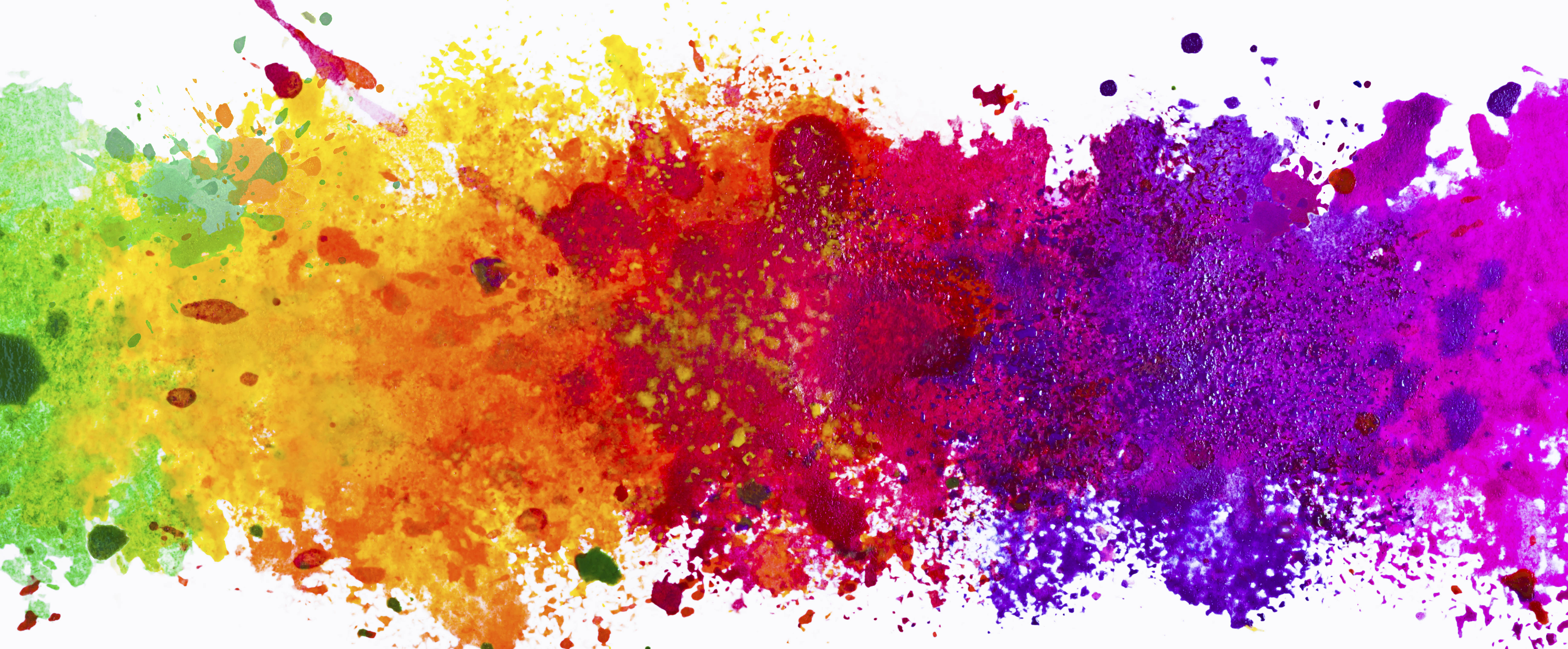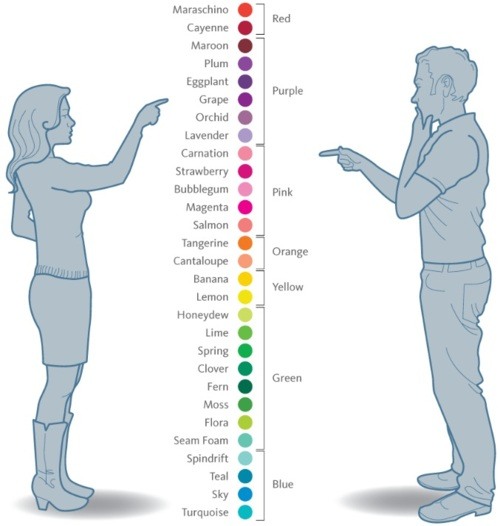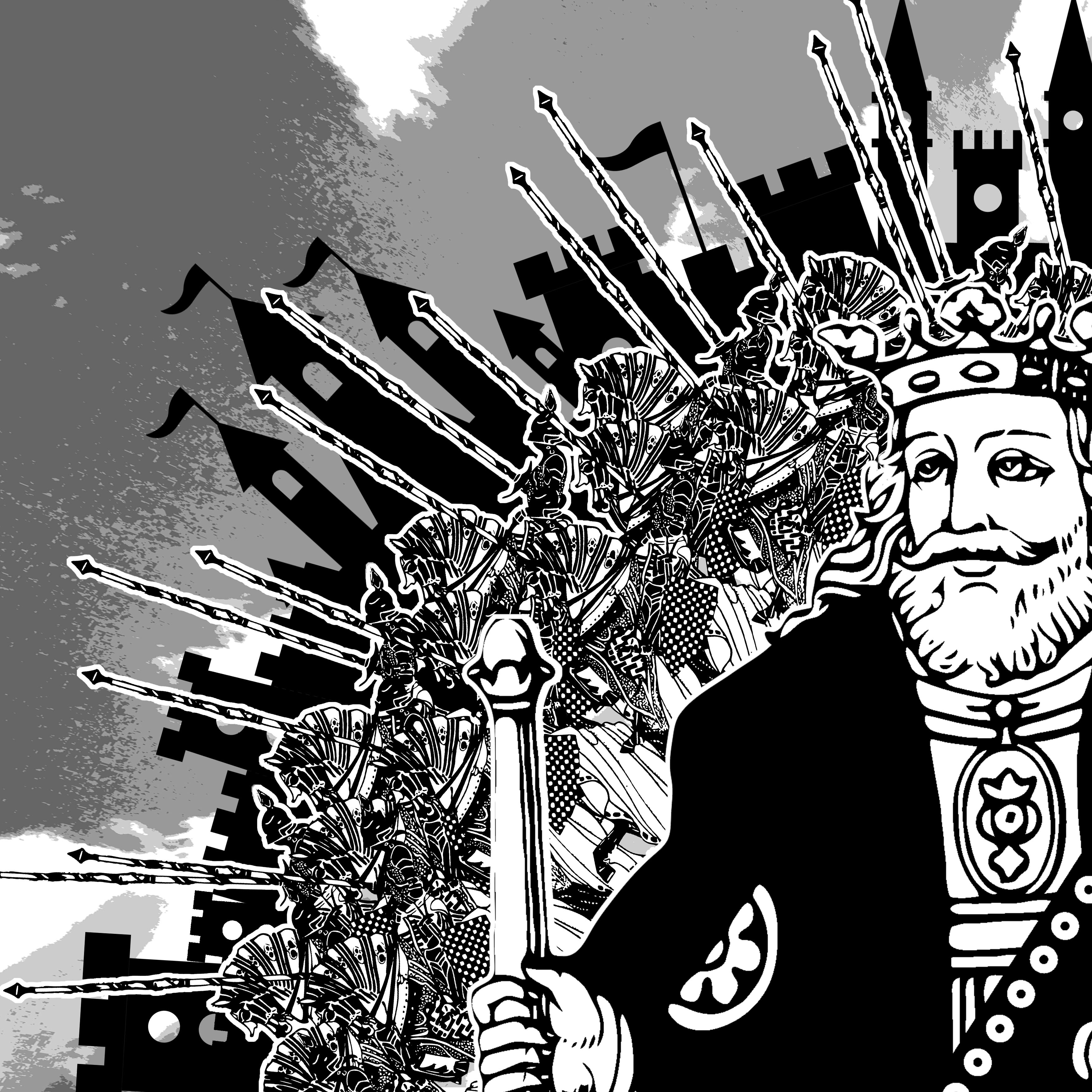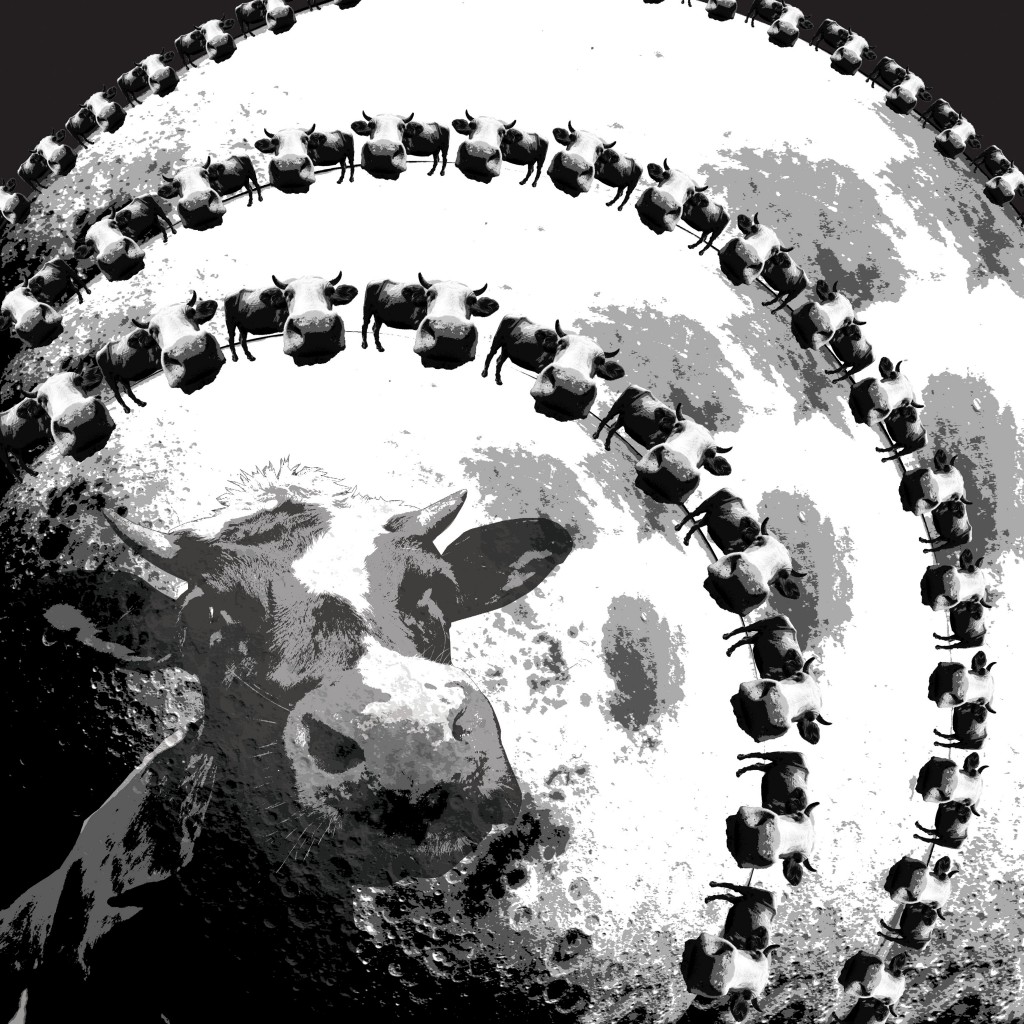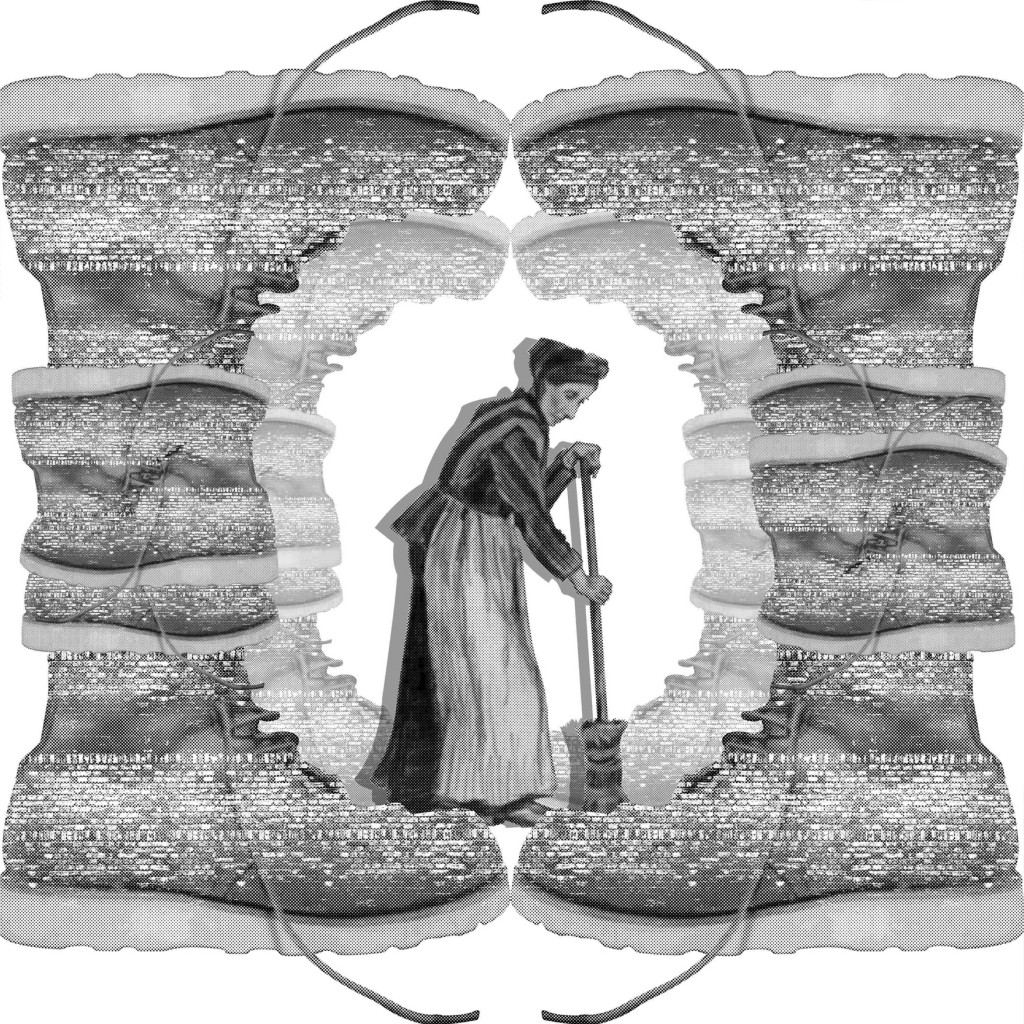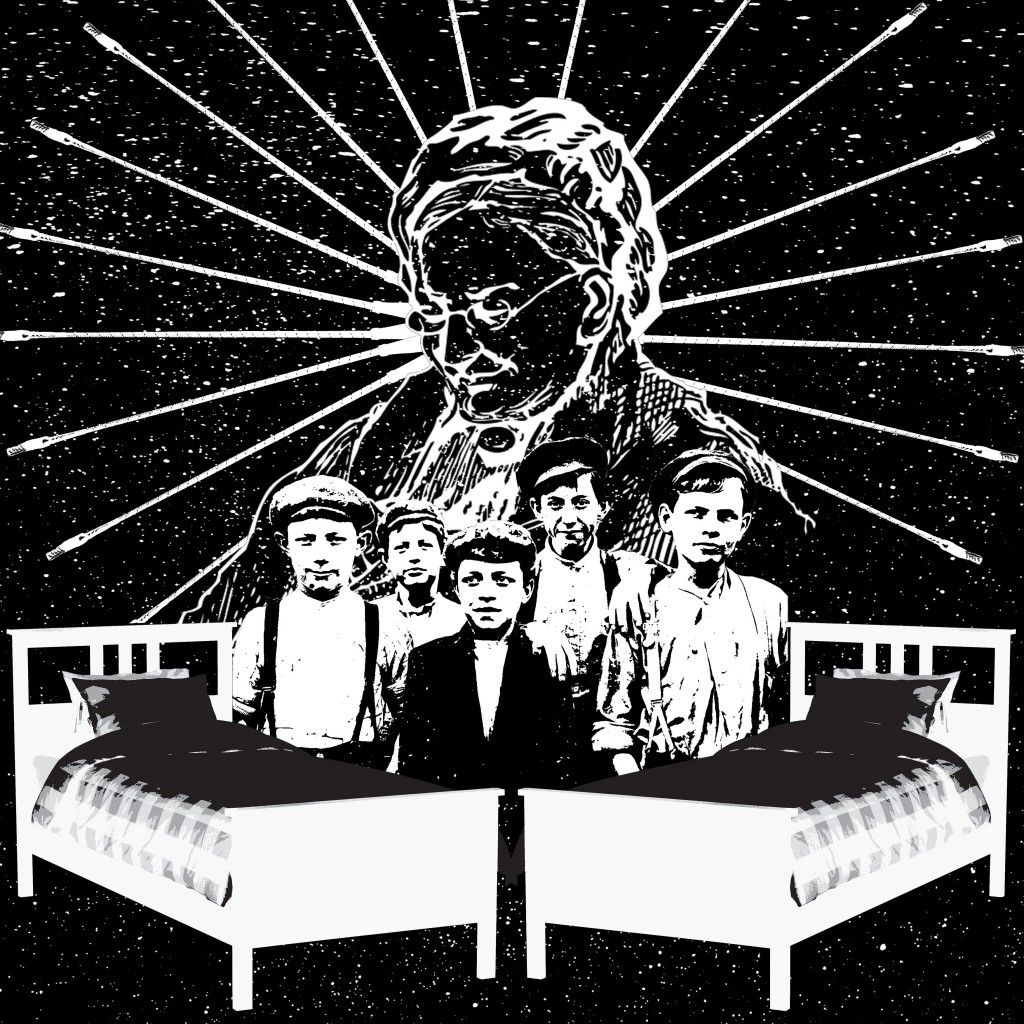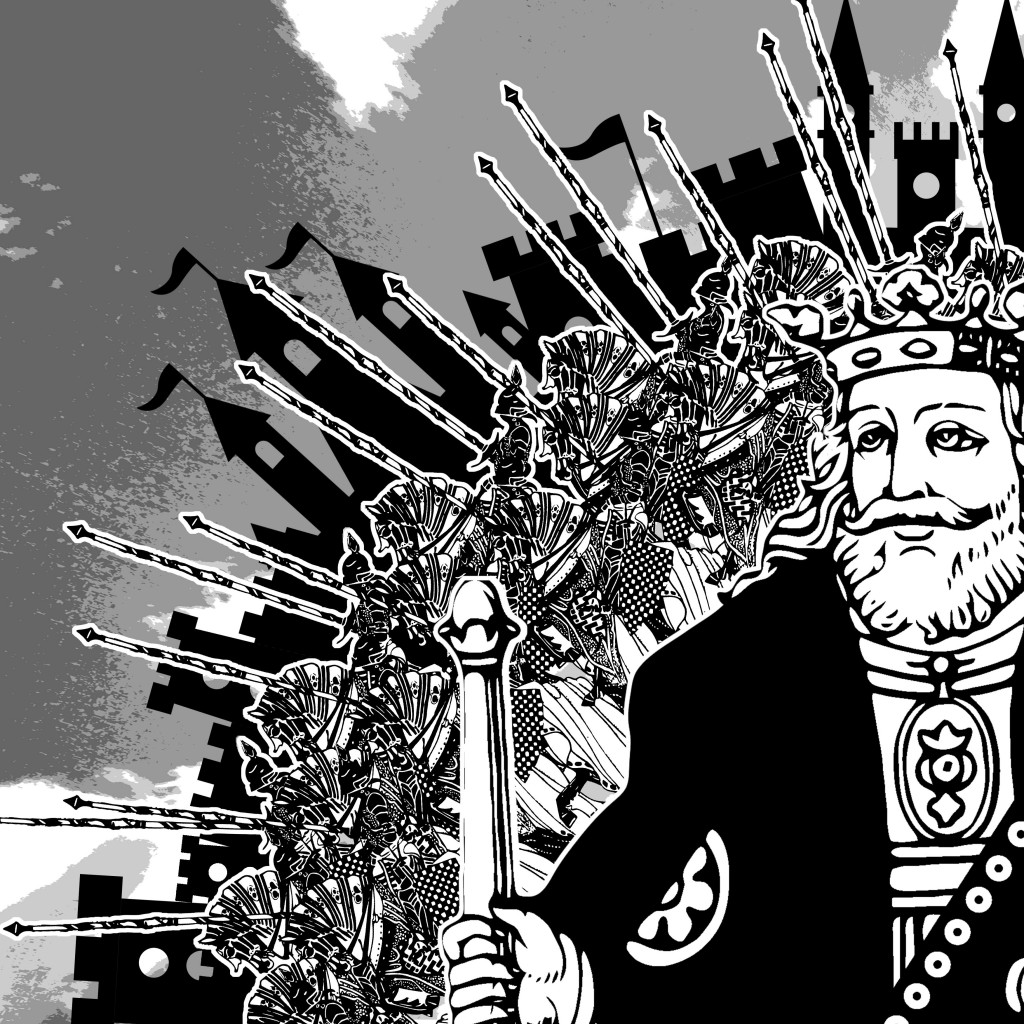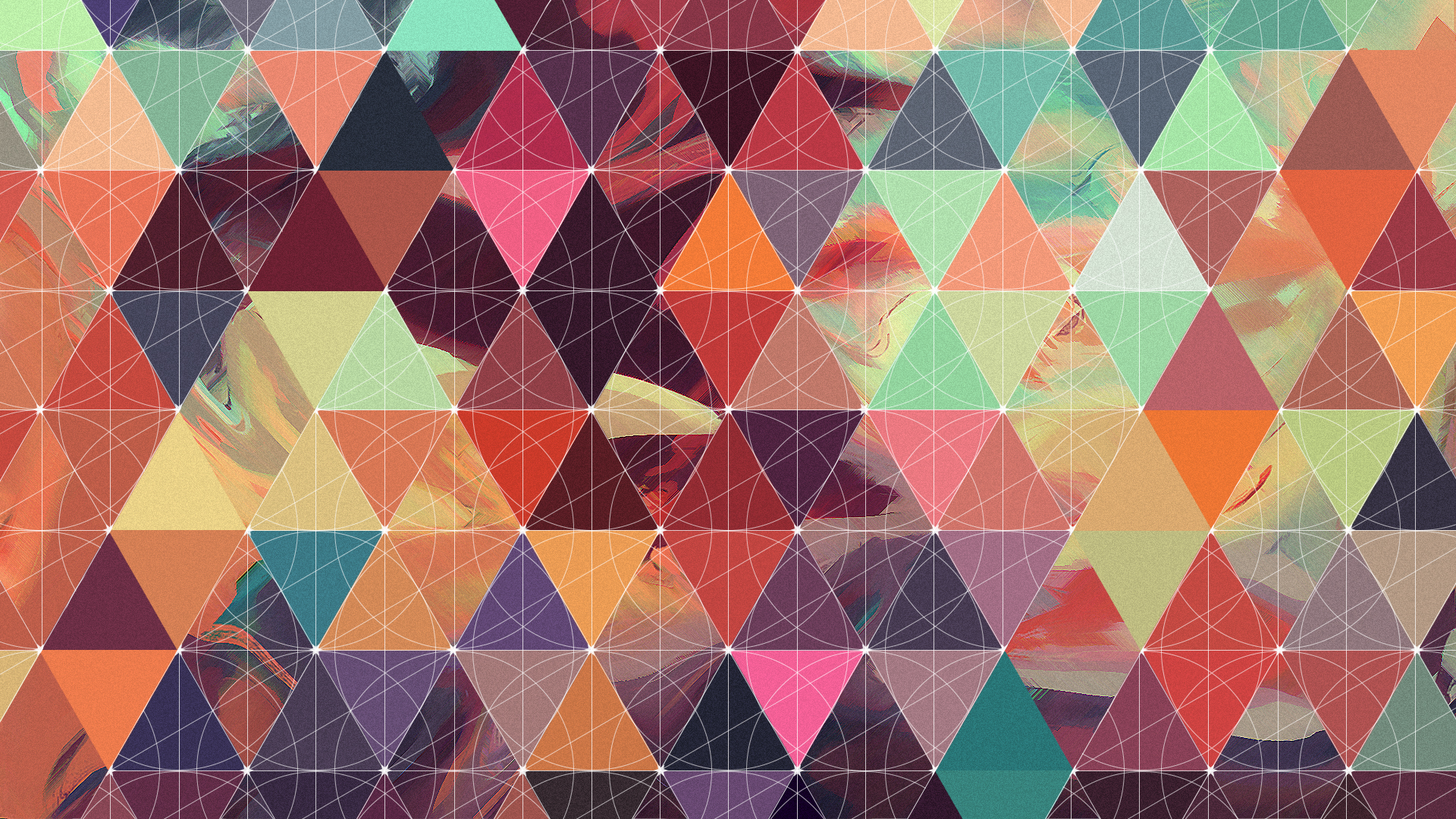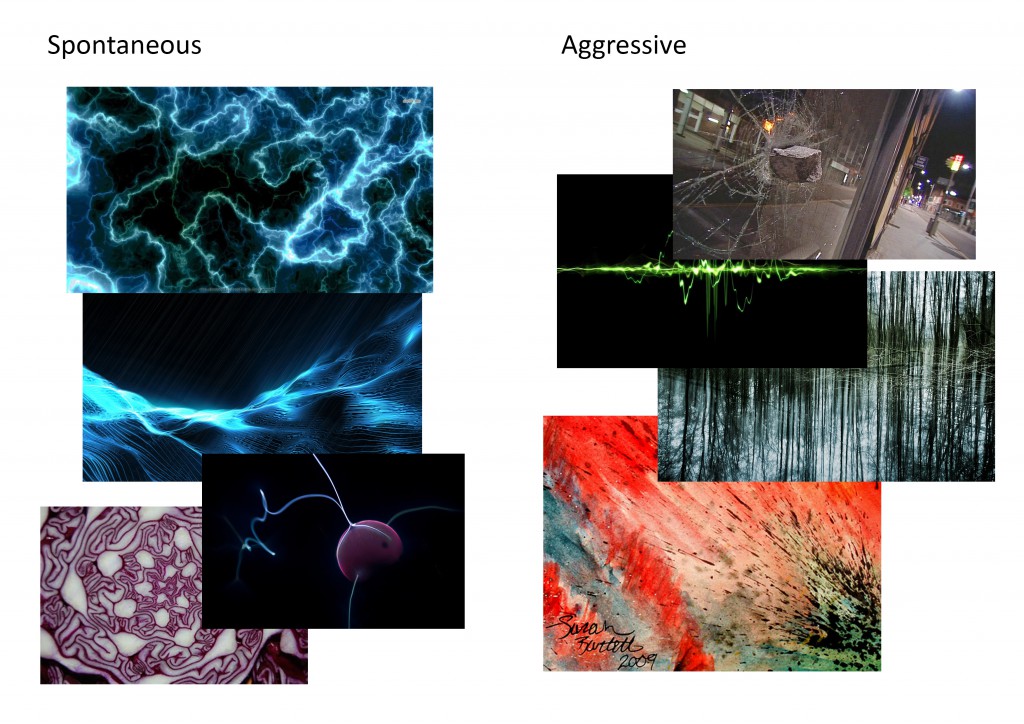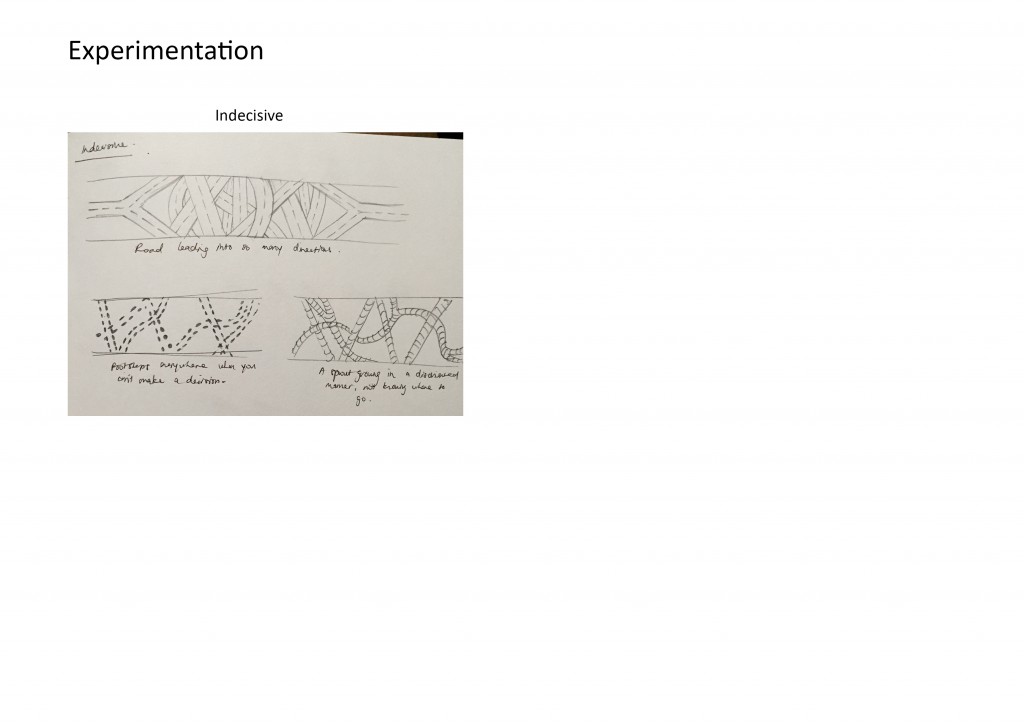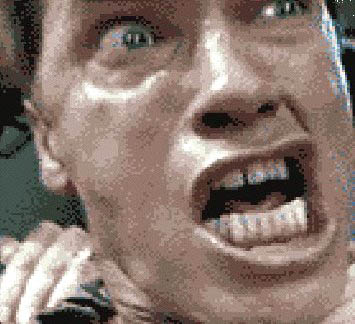
Greetings!
I am exceptionally pleased to share with you a little bit about myself through this final assignment.
Ego [/ˈiː.ɡəʊ/]
The “I” or self of any person; a person as thinking, feeling, and willing, and distinguishing itself from the selves of others and from objects of its thought.
I find myself highly eccentric and congenial, and I have attempted to make that evident in my equations for this project. I have chosen to display my panels in digital illustrations as I am more proficient in Photoshop and I am given more liberty to experiment with colors without discounting quality and obscuring the message behind the images.
My overall theme for these equations revolve around plants and light. Plants are generally viewed as an organism where growth, stability, and potential are innate in them, even as seeds. And light is the ultimate source of energy that allows plants to reach their full potentials. I feel that I am a plant, and time and my life experiences are the light. Every opportunity and challenge pushes me to greater heights. That is where my ego lies. That is the factor I feel best distinguishes me from so many others.
I have also incorporated my knowledge of design elements and design principles from previous assignments to come up with the ideal composition for my panels, with colors carefully taken into consideration.
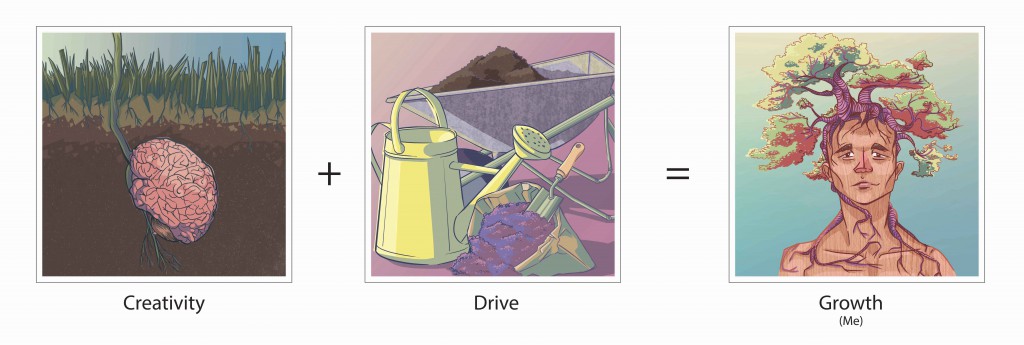
For the first equation, I have added “Creativity” and “Drive” to represent the current stage I am in my life – “Growth” (me).
Creativity:
I have always thought of myself as someone with great ideas and someone who often thinks outside the box. In the first panel, I portrayed myself as a brain-seed, germinating, and paving through the earth to reach for the light beneath the grass. I have employed and analogous color harmony for this composition to give a calm and naïve beginning to my set of equations.
Drive:
Drive is motivation to propel you forward and upward. It provides the necessities in one’s growth and show the amount of potential that one has. That is why I have chosen gardening tools and essentials, such as a spade and fertilizer, to represent this aspect of my equation. When potential comes to mind, I think of vibrancy. And what could better infer that than a complementary harmony. I have contrasted yellow and purple to show energy and nobility in the objects present in the composition. I have also arranged them in a way to produce harsher diagonals to increase dynamism.
Growth (me):
Growth is a stage by stage process of development. I have painted a self-portrait, with an expression ready to face the world, while cladded in the roots and branches of a Bonsai tree. The Bonsai symbolizes harmony, peace, order of thoughts and balance. This is why I have employed a symmetry to the composition to further elevate the balance aspect of the image. I have also used a split-complementary color harmony to create a relaxed overall ambience.
For the second equation, I have subtracted my “Insecurities” from my “Ambition” to derive into an improved version of my current self – “Aggrandizement” (a better me).
Ambition:
We often set goals for ourselves. And our goals are seen as something beyond reach. So with the idea of soaring high and having a huge desire for success, I feel that a giant beanstalk could best embody those traits. I have made the beanstalk colossal, shooting to the skies and vanishing into the clouds. The composition consists of a strong diagonal cutting across the panel and slowly diminishing into the corner. I have also used bold colors such as orange and red to represent confidence and passion, and I contrasted it with a sea-green to make the beanstalk more emergent.
Insecurities:
Everyone has struggled with insecurities. They are the little things inside you that constantly remind you of how unsure, undecided and how incompetent you are. And that is the aspect that I wish to rid of. I have paired the vulnerability of a fetus inside a sprouting seed (me) with dozens of aphids surrounding it. The fetus is encapsulated in a blue womb to show protection and comfort while the outside is yellow to hint danger. And the green leaf represents life. Aphids are regarded as a garden’s worst enemy since they destroy plants. But if the aphids were viewed from a distance, they could be seen as sunlight, which on the flipside, nurtures the garden instead. So what I thought could kill me would only make me stronger. This panel has an analogous color harmony.
Aggrandizement (a better me):
Aggrandizement is where you acquire a higher or better position of yourself. And at this point, I wanted to show how much I’ve grown from the previous panel. I have made another self-portrait of me, now bearing flowers. I used red for the flower to display power and strength, over a calmer and cooler green in the background. I have changed the color of the light source to be blue, to show how my growth has transpired over to a later time of day. A sense of maturity and change.
For the third equation, I multiplied “Receptivity” by “Network” to evolve into the ultimate form of myself – “Influential” (an ideal me). For this 3 panels, I would like to include external factors that could possibly evolve me into the person I see myself to be in the end.
Receptivity:
Part of development largely consist of taking in criticism, critique and judgement. No matter how much it might tear you apart at the start, it only builds you up to make you better and stronger. And the willingness to learn, to accept others’ views and opinions, and to take in their advice would put us at a higher pedestal. I have combined metal railings and solar panels in the shape of a tree to represent receptivity. The solar panels, being the receptors, absorb the solar energy to power up the rest of the tree. I have used an analogous color harmony for this panel.
Network:
Wherever you go, network is key. Whether if it boils down to finding a job or finding your other half, network is everything! Bees are nature’s network. They fly from flower to flower resulting in pollination – the starting source of an entire ecosystem. I have employed a triad color harmony to make purple and red more dominant in the composition.
Influential (an ideal me):
Ultimately, I want to be known for the work I produce and I want to be able to inspire others through my success stories. Another self-portrait! Only now, I am featured in Time magazine and I happen to have grown a bushy beard (literally)! This panel is heavily inspired by Cal Redback’s photography. And I have used a complementary color harmony for this panel.
For the final equation, I wanted it to be subjective so you could read it as either add or subtract. “Success” could be with or without “Humility”, and that would determine one kind of “Empire” (me in 5 years) I wish to become.
Success:
Fruits of success! It’s the easiest bet and has the most relevance to the theme that I am going for. Success is when I start bearing fruits. Seeing how much I have grown and how my hard work and effort finally paying off. I have drawn the fruits in geometrical shapes to give it a more futuristic look since it would be me in 5 years to come. I have gone with a square color harmony to increase the vibrancy of the whole image. And I have built a triangular composition as a peak/hallmark of my career.
Humility:
For this panel, I referred back to my very first image to show how much I have grown. We can see how my legs are rooted to the ground while I dispersed more seeds into the ground, hoping that there would be more I could do and provide for others. The color scheme is earthier and much more humbling in this composition. While the harsh and elongated shadows created from the setting sun reveals a victorious end to the day. I wanted to display a sense of maturity and wisdom in the panel as well.
Empire (me in 5 years):
This composition makes us all feel very small. That one little seed that we saw germinating in the first panel has finally grown into a colossal garden of hopes and dreams. Part of me wants to see how much I would have overcame in the coming few years, while a smaller part of me is fearful of the kind of person I will turn out to be with all the success in the world. That is all represented by the hidden sun, seeping light behind the leaves and branches. Somewhat ambiguous but somehow exciting. The leaves are orange to show the birth of a new season, and an end to all the hardship and milestones I have conquered. Orange is the color of success, and sadly it is also the color of ignorance…
This is how the panels look like put together. If you noticed, I used a fair amount of textures in every of my compositions to make them more visually appealing and give a sense of space and form to the objects and environment. And that’s it, folks! I hope you enjoyed going through my panels and learning more about the story and concept behind it. And I hope through this project, you have learned so much about me.
Thank you for your time.
P.S. You can follow me on instagram: anammustaein. My ego’s bigger there!
Regards,
Anam
